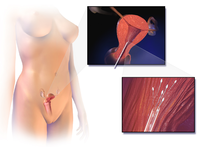
Photo from wikipedia
CASE DESCRIPTION A 7-year-old sexually intact female snow leopard (Panthera uncia) was examined because of blepharospasm, periocular discharge, ventral deviation of the upper eyelid cilia, third eyelid prolapse, and corneal… Click to show full abstract
CASE DESCRIPTION A 7-year-old sexually intact female snow leopard (Panthera uncia) was examined because of blepharospasm, periocular discharge, ventral deviation of the upper eyelid cilia, third eyelid prolapse, and corneal opacity of the right eye. CLINICAL FINDINGS An ophthalmic examination performed with the patient anesthetized revealed a 3 × 3-mm ulcer that extended approximately 60% of the depth of the right cornea and was accompanied by perilesional and intralesional cellular infiltrates and active vascularization. The upper eyelid of the right eye also had a previously repaired coloboma resulting in trichiasis. TREATMENT AND OUTCOME Surgical intervention was elected after 5 weeks of medical management including topical administration of autologous serum and topical, subconjunctival, and systemic administration of antimicrobials failed to yield any improvement in the ulcer. Equine amniotic membrane free-island graft placement and eyelid revision surgeries were performed. Two and a half weeks later, a descemetocele was diagnosed ventrolateral to the original ulcer, and a second equine amniotic membrane free-island grafting procedure was performed. Both grafts healed without further intervention. CLINICAL RELEVANCE Equine amniotic membrane free-island grafts were used to successfully repair a corneal ulcer and descemetocele in a snow leopard. The grafting procedure spared the affected globe and resulted in satisfactory cosmesis and functional vision. This procedure should be considered as an option for corneal repair in nondomestic species for which postoperative care and medical treatment options are limited.
Journal Title: Journal of the American Veterinary Medical Association
Year Published: 2018
Link to full text (if available)
Share on Social Media: Sign Up to like & get
recommendations!